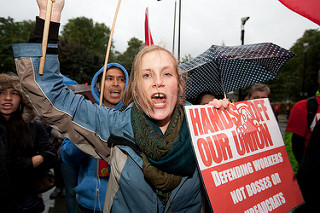Attempts to unionise cleaners in the City of London have shone a spotlight on an exploited group of largely immigrant workers. Gregor Gall, Professor of industrial relations at the University of Bradford looks at how the campaign was built.
At the very base of the union movement, new life is being injected into it by the offshoot of a very old organisation. The Industrial Workers Great Britain (IWGB) emerged out of the Industrial Workers of the World (IWW, or Wobblies) in Britain after differences of opinion about strategy and tactics. The IWW whose slogan is ‘one big union’ for all workers began life in the United States in 1905.
Existing and operating on less than a shoe-string budget, the IWGB is organising groups of cleaners, particularly in London and especially amongst migrant workers. This is a great testament to the activists involved because organising workers who are particularly vulnerable and insecure, and whose first language is not English is a particularly challenging task.
Striking at the City
Last week, IWGB cleaner members went on strike at the Barbican Centre in London which is owned by the City of London Corporation. The significance of choosing that particular for strike action was that it was the polling day for the City of London Common Councilmen elections.
The cleaners are employed by the sub-contractor, MITIE, and are paid the minimum wage of £6.19. They have been campaigning for the London Living Wage of £8.55 per hour since 2012. The strength of feeling amongst the 32 cleaners was shown in the strike ballot which saw a 71% turnout with a 100% yes vote.
But the cleaners are also campaigning to be treated with respect and dignity at work because they have experienced management behaviour which is often, in their words, ‘offensive, intimidating, malicious and insulting’. Indeed, the IWGB has undertaken an Employment Tribunal case for one pregnant cleaner whose ill-treatment was such she was taken to hospital after being found collapsed and bleeding in the toilets.
London Living Wage
Although the City of London Corporation holds more than £1.3bn in its account which is there to ‘benefit … London as a whole’, it has told the cleaners that they must wait until 2014 before it applies it support for the London Living Wage to its contract with MITIE. Along the way, MITIE has tried to deny the cleaners and IWGB members access to the IWGB.
Last year July, cleaners at the John Lewis Partnership at its flagship Oxford Street store struck to support their claim for the London Living Wage. The 33 workers, again organised by the IWGB, are employed by sub-contractor, Integrated Cleaning Management (ICM). They won a pay rise of 10%, taking their hourly pay to £6.72 but this was still short of the £8.55 London Living Wage. But there was also a sting in the tale as ICM reneged on its commitment to work towards paying the London Living Wage.
The IWGB is also active in organising cleaners at the offices of the large European Bank, Société Générale, in London. Again they are employed by a sub-contractor, Initial Facilities. The cleaners there were successful in gaining the London Living Wage. But there was another, and bigger, sting in the tail as Initial cut their hours by half and forced them to increase their work rate so that they cleaned the same amount of floor space in 50% less time. They ended up being worse off than they had been before the pay rise. Moreover, many who protested against this were suspended from work and non-union cleaners were brought in.
The IWGB has also recruited and organised cleaners at the Tower of London, Schroder’s bank in the City, the Guildhall, Exchange Tower, Canary Wharf and at the St Georges University of London and Capgemini in Vauxhall.
Reaching New Layers of Workers
The IWGB is attempting to show in practice parts of the rest of the union movement that not only can what are commonly described as ‘difficult to organise’ be unionised but that they can be unionised in such a way where they play a greater than usual role in their own organising. But, of course, this takes guts and determination as well as a long-term orientation to do so.
It is not that other unions are not organising cleaners as the work of Unison with the cleaners at Senate House, SOAS and Birkbeck college shows. Unite has also organised cleaners at the House of Commons amongst others.
But what the IWGB shows is that so much can be done with so little in terms of resources. If the same method of using their greater resources was applied to their work in the sector by the established unions then, presumably, so much more could be achieved.
Critically, the union movement might then get to a point where it could start having an ‘industry effect’, namely, that as most of the major cleaning subcontractors recognise unions and pay union rates, the disincentive to undercut on terms and conditions is removed because a common floor of wages and conditions is established. What they compete on is quality of service.
